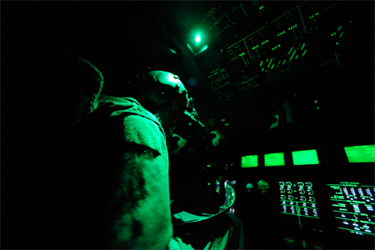The Use Of Hyperspectral Imaging By The Military

By John Oncea, Editor

Hyperspectral imaging is used in many industries, including defense. The data mined from this process can be the difference between winning and losing a war.
Hyperspectral imaging (HSI) is being used to transform environmental monitoring, pick the perfect pepper, and study living organisms and life processes. It is also being used by militaries around the world to provide detailed and accurate information for various operations and threat detection.
What is the process, and how, exactly, is the military using it, including in the Ukraine-Russia conflict and the Israel-Hamas war?
Creating HSI Images
HSI combines optical spectroscopy with imaging to create a multidimensional dataset where each pixel contains both spatial and spectral information, explains Geeks for Geeks. This results in a three-dimensional data cube (Hypercube) with spectral bands representing different wavelengths.
These bands usually sample more than 20 equally distributed wavelengths, which extend beyond the visible range into the ultraviolet and infrared regions. This integration allows for a comprehensive analysis of spatial and spectral information in a single data set.
“Hyperspectral imaging is like having super-powered vision, writes Geeks for Geeks. “Normal cameras see the world in just red, green, and blue. Hyperspectral cameras go way beyond, seeing hundreds of colors, even the ones our eyes can’t detect. This lets them pick out the tiny differences in how things reflect light, revealing hidden details about materials, plants, or even hidden objects.”
Creating HSI images begins with the collection of raw hyperspectral data cubes, three-dimensional datasets where two dimensions represent spatial information, and the third dimension captures spectral information across various wavelengths. Each pixel in these cubes contains a wealth of spectral properties, offering insights into the composition and characteristics of the imaged area.
Once the raw data is acquired analysis can begin, starting by cleaning the data cubes by removing unwanted noise and distortions that could compromise the accuracy of subsequent analyses. Researchers meticulously assess image quality, examining factors such as resolution, clarity, and overall fidelity to ensure the data is reliable and ready for in-depth examination.
To enhance the clarity of spectral features and reduce noise, analysts employ the Savitzky-Golay filtering method, allowing researchers to identify patterns and anomalies more easily in the data, setting the stage for more accurate analysis and interpretation.
Next, specific areas of interest within the data cubes are assigned labels or categories. This process helps identify regions with distinct spectral signatures, such as different types of land cover or material compositions. By providing this context, analysts can better understand and interpret spectral data about real-world features.
Selecting relevant spectral bands is the next step, and not all spectral bands are equally informative for every analysis so researchers carefully select the most relevant bands based on their specific objectives. This targeted approach allows them to focus on particular features or properties of interest while simultaneously reducing the complexity of the data. The selection process is crucial for optimizing the analysis and ensuring that the most pertinent information is highlighted.
The final step in creating HSI images involves categorizing pixels based on their spectral signatures. This classification can be achieved through various means, including advanced machine learning algorithms or by referencing spectral libraries. The goal is to sort pixels into different classes or categories, such as specific land cover types or material compositions. This classification transforms complex spectral data into meaningful, interpretable information.
HSI image creation allows researchers and analysts to glean deep insight into the composition and characteristics of the imaged area, pushing the boundaries of what we can observe and understand about our world.
HSI And The Military
“HSI is deployed in military and security contexts for target and camouflage detection, as well as surveillance,” Geeks for Geeks writes. “It provides vital intelligence for reconnaissance and threat detection.”
HSI is also used to identify targets quickly and precisely, with each pixel representing an area of around 1-2 square meters. Known parameters can be used to narrow down possibilities and reduce the chance of false positives.
In addition, HSI can help detect chemical and biological threats, and an emerging application is its use to detect early signs of corrosion and metal fatigue on aircraft and naval vessels. This helps in maintaining expensive military assets and improving operational readiness.
On the ground, HSI can help detect buried landmines and IEDs, as well as distinguish between soil disturbances caused by these devices and other disturbances, such as vehicle movement. Small, lightweight, customized Commercial Off-The-Shelf (COTS) sensors are used for checkpoint inspections, spectral tagging, and border control.
In the air, hyperspectral sensors are integrated into numerous military platforms including small satellites, high-altitude reconnaissance aircraft, medium-altitude commercial aircraft, and medium- and low-altitude unmanned aerial vehicles.
Data mined from HSI is distributed rapidly, enhancing real-time decision-making in military operations. Defense organizations conduct collaborative trials with international partners to collect and analyze high-fidelity hyperspectral information, leading to advancements in surveillance techniques and identifying areas for further research.
HSI is being utilized in both the Ukraine-Russia conflict and the Israel-Hamas war in the ways noted above. While specific details of military applications are not publicly available due to security concerns, the ongoing conflicts have likely accelerated the development and deployment of HSI technologies for defense and surveillance purposes. The technology’s ability to provide detailed information across a wide range of electromagnetic wavelengths makes it a valuable tool in modern warfare and post-conflict assessment.
